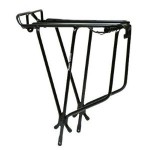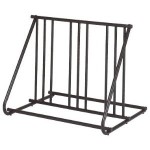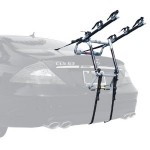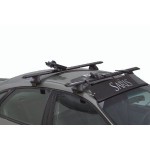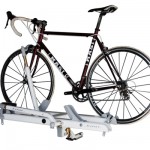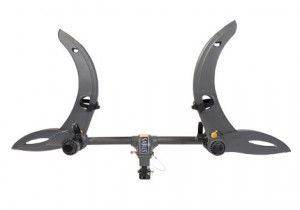
Get your minds out of the gutter and follow along here.
It is finally time for me to purchase my own bike rack so I don’t always have to rely on Mr. Powers and his Saris Thelma 3-Bike Platfrom hitch rack.
Oh, what is a hitch rack you ask???
Heck if I know!!! It’s the thingy that Chris has on his truck!
Thankfully, Gary Thornton runs the whimsical bicycle lifestyle blog ‘My Life Behind Bars‘ at www.velorambling.com and he was kind enough to put this guide, about the different type of bicycle racks together for us.
The three most common types of racks for transporting bicycles on automobiles are trunk, roof and hitch mounted.
These are not to be confused with bicycle racks for carrying items with your bicycle.
Often times, when asking for a bicycle rack, you will be questioned as to whether it is for a car or for your bike. When doing an internet search for “bicycle rack” the results are evenly split.
There is even the possibility, that just asking for a bicycle rack, you will be led to a parking rack for bicycles, so be specific.
In addition to the three most common types of automobile bicycle racks there are also spare tire mounted racks. These are limited specifically to vehicles that have a spare tire mounted on the rear of a vehicle.
The most well-known bicycle rack manufacturers that sell all three styles are Thule, Saris, and Yakima. Allen and Graber also sell trunk mounted versions and there is a newer company, Kuat, for hitch mounted racks.
A good place to start your search for the best type of rack is to first find out which are compatible with your vehicle; consult the fit guide from the rack manufacturer of your choice. A retail store that stocks racks will have the fit guide or you can visit the company’s website.
Generally recommended for people that do not want a rack on their car at all times or are occasional cyclists.
Pros
- Least expensive option
- Most easily removed
- Most easily stored since most fold somewhat flat
- Can work on sedan style cars but also vehicles with flat rear ends such as minivans, hatchbacks, or wagons consult individual manufacturer’s fit guide
- Convenient to put bike’s on since do not have to raise over head
Cons
- Bicycles are not as stable on rack
- Potential to cause paint damage on vehicle if installed improperly or when vehicle is very dirty
- Can be difficult to fit nonstandard frames such as ladies style bikes or very small frames, due to the fact that the bicycle rest on arms slid through the frame. Bicycles will sit at an awkward angle or not have a place at all. An adaptor that connects between the seat and handlebars can alleviate this problem. This can be an issue with some hitch mounted racks that don’t secure the bicycle via the wheels as well. The Saris Bike Beam is an example of this.
Best known for their roof racks are Yakima and Thule. Check the manufacturers guide for compatibility with your vehicle. These are generally left on the car once installed (can be a pro or a con depending on viewpoint)
Pros
- The most versatile of the rack systems. These can be adapted to hold other types of sporting equipment such as ski’s, kayaks and cargo.
- Very secure and stable connection for rack to vehicle
- Secure stable connection for bicycle to rack
- Wide variety of securing options
Cons
- Can be difficult to raise bicycle overhead and secure it.
- Can limit sunroof use
- Can create wind noise
- Difficult to access center of rack most people utilize outsides of bars for their equipment
- Some require removing the front wheel
These are limited to vehicles that have hitch mounts currently installed or can have them installed. Check with your vehicle manufacturer for compatibility. A hitch mount, can range in cost from one hundred to several hundred dollars just to install. This does not include the cost of the rack, just the hitch itself.
You will need to find out if your hitch mount is a 1¼” or 2” receiver which are the two standards. A 1¼” receiver is generally only going to be rated to carry two bicycles where a 2” can go up to five depending on the rack.
Pros
- Easy to load bikes due to the fact that they are at chest level.
- Two styles: an arm style that the bicycle hangs on. (see last section of cons in trunk mounted racks) or a wheel mounted rack.
- Arm style generally less expensive
Wheel mounted racks such as the Saris Thelma or Kuat Sherpa.
In my opinion wheel mounted racks are a better choice if using a hitch mount.
- By touching only the tires they eliminate frame compatibility issues.
- Stable connection. Bicycles do not sway around as they would on an arm style rack
- Ease of securing for the user, just secure front and rear wheel and you’re done.
- Protect bicycle frame finish from scratching.
- No worries about clamping on thinner frame materials such as lighter aluminum or carbon fiber.
- Keep bicycles away from each other. Arm style racks can allow bicycles to swing into each other if not tied down properly (additional steps needed to do this)
- Generally easy to take off. Just slide out of hitch.
Cons
- Clearance issues, on some vehicles that are closer to the ground such as station wagons the underside of the rack can hit the ground occasionally. For example: When going over speed bumps or entering a steeper driveway. This generally won’t effect the bikes but does make a startling grinding noise that is not the best for the rack
- While generally easy to take off can be difficult to store since they don’t fold flat
- Can be heavy to lift
- Some wheel mounted racks may have issues with 29er mountain bike wheels. These are the biggest commercially used wheels. Check with manufacturer for compatibilty
- Make vehicle longer. Can make it more difficult to parallel park or easier to back into item’s. Speaking from experience, I’ve backed into a tree and knocked over my neighbor’s trash cans, even after using this style for over a decade.
These racks are exposed to the elements and if left on (which many cyclists do) can experience corrosion.
—
Thank you Gary for explaining the differences.
Since I’ve decided to go with a hitch rack and want to carry at least 3 bikes, we are going to review the Saris Thelma and the Kuat Sherpa next.
Stay tuned…

